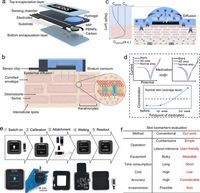A new wearable sensing patch has been developed that could revolutionize personalized skin healthcare by facilitating the direct sampling and real-time measurement of epidermal serine levels, a crucial biomarker for assessing skin barrier integrity. This innovative technology addresses an often overlooked aspect of skin health, targeting conditions such as atopic dermatitis (AD) that are profoundly affected by the skin’s barrier function.
With the increasing prevalence of skin issues linked to barrier dysfunction, including eczema and psoriasis, there is a pressing demand for effective monitoring tools. Traditional methods of skin assessment rely largely on invasive techniques, which can be uncomfortable. However, portable biosensing technologies are emerging as viable alternatives, as they allow for continuous and non-invasive monitoring while providing immediate results.
The serine sensing patch designed by researchers integrates several key components: a porous hydrogel that facilitates the diffusion and ionic conduction of serine, and a molecular imprinted polymer (MIP) sensor that captures serine molecules with high specificity. When applied to the skin, the patch captures serine and transmits data to a handheld device for real-time analysis, akin to the functionality of glucose monitors widely used by individuals with diabetes.
“Our work opens up a potential application scenario for portable biosensors in personalized skin healthcare,” wrote the authors of the article, highlighting the impact of this advancement.
The importance of serine cannot be overstated; it is a vital component of natural moisturizing factors (NMFs) produced in the skin. These substances play a significant role in maintaining hydration and skin barrier structure. Variations in serine levels can directly reflect skin health, providing an opportunity for early diagnosis of skin disorders. Notably, serine is crucial for the skin’s chemical barrier and plays essential roles in immune response and keratinocyte turnover.
The device thus holds immense promise for both everyday skincare and clinical applications, particularly in tracking the effectiveness of skincare products. Following application of a moisturizing essence, the serine sensing system demonstrated significant increases in skin hydration, reflecting improvements in skin barrier function. This was particularly notable in subjects with atopic dermatitis, who showed marked improvement in serine levels during recovery treatments.
Another key finding from the research was the strong correlation between serine levels and other skin health metrics such as transepidermal water loss (TEWL) and stratum corneum hydration (SCH). This provides compelling evidence supporting the patch's ability to serve as a reliable indicator of skin health and treatment efficacy. “Epidermal serine levels showed strong correlations with skin health metrics,” asserted the authors of the article.
The system’s design focuses on user-friendliness, with a simple operation procedure that allows patients to conduct their own evaluations at home, without needing continuous visits to healthcare providers. This not only enhances patient engagement in their treatment plans but also offers flexibility concerning daily skincare routines.
The patch has already been successfully tested on patients undergoing treatment for atopic dermatitis, showcasing its ability to distinguish between lesion and normal areas of skin. Over a period of three weeks, patients' serine levels were monitored and demonstrated significant increases, paralleling clinical improvements in skin appearance and feel.
This innovative technology is set to substantially impact dermatological practice, enabling more personalized treatment strategies for patients. For instance, dermatologists may use serine levels as a biomarker to evaluate the effectiveness of specific formulations or treatment plans in real-time, allowing for proactive adjustments based on immediate feedback.
As the field of wearable biosensors continues to grow, this work signals a critical step towards integrating molecular-level analysis within everyday health monitoring. Future research could further expand upon this platform, potentially adapting the technology for monitoring other skin metabolites or conditions beyond those targeting just hydration.
Overall, the development of this wearable serine sensing system not only enhances our understanding of the complexities of skin health but also opens new avenues for personalized medicine, enabling individuals to maintain healthier skin through informed and precise monitoring.




